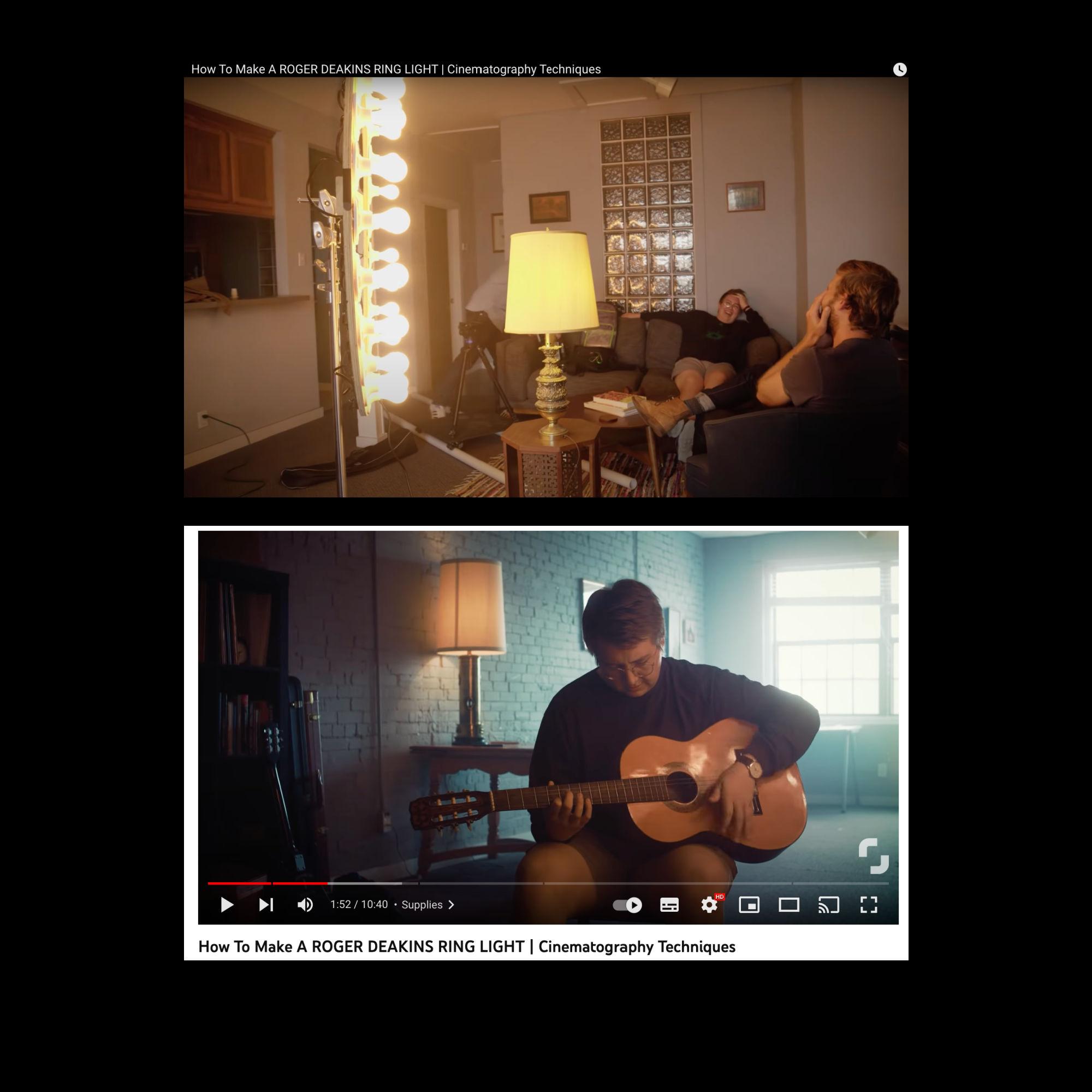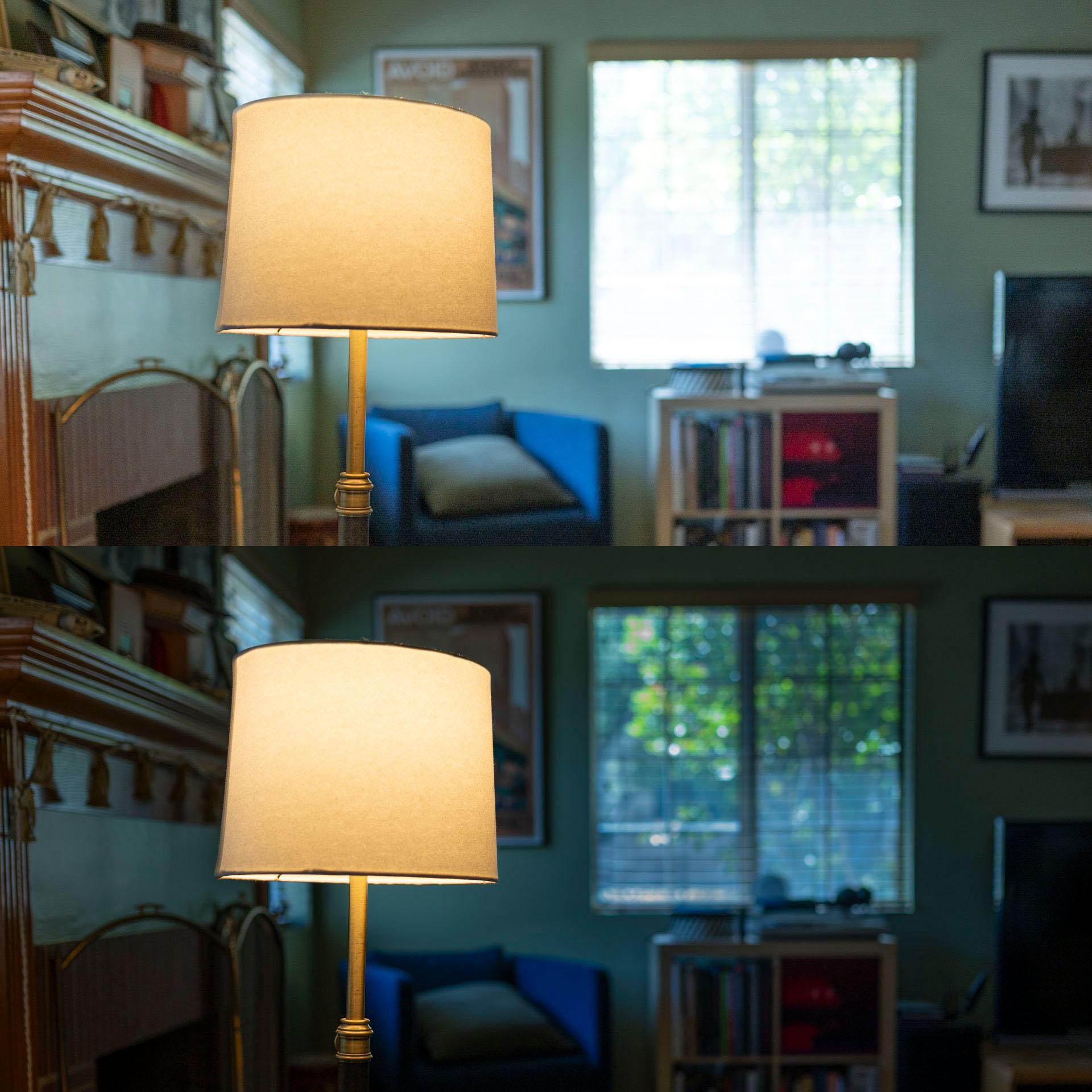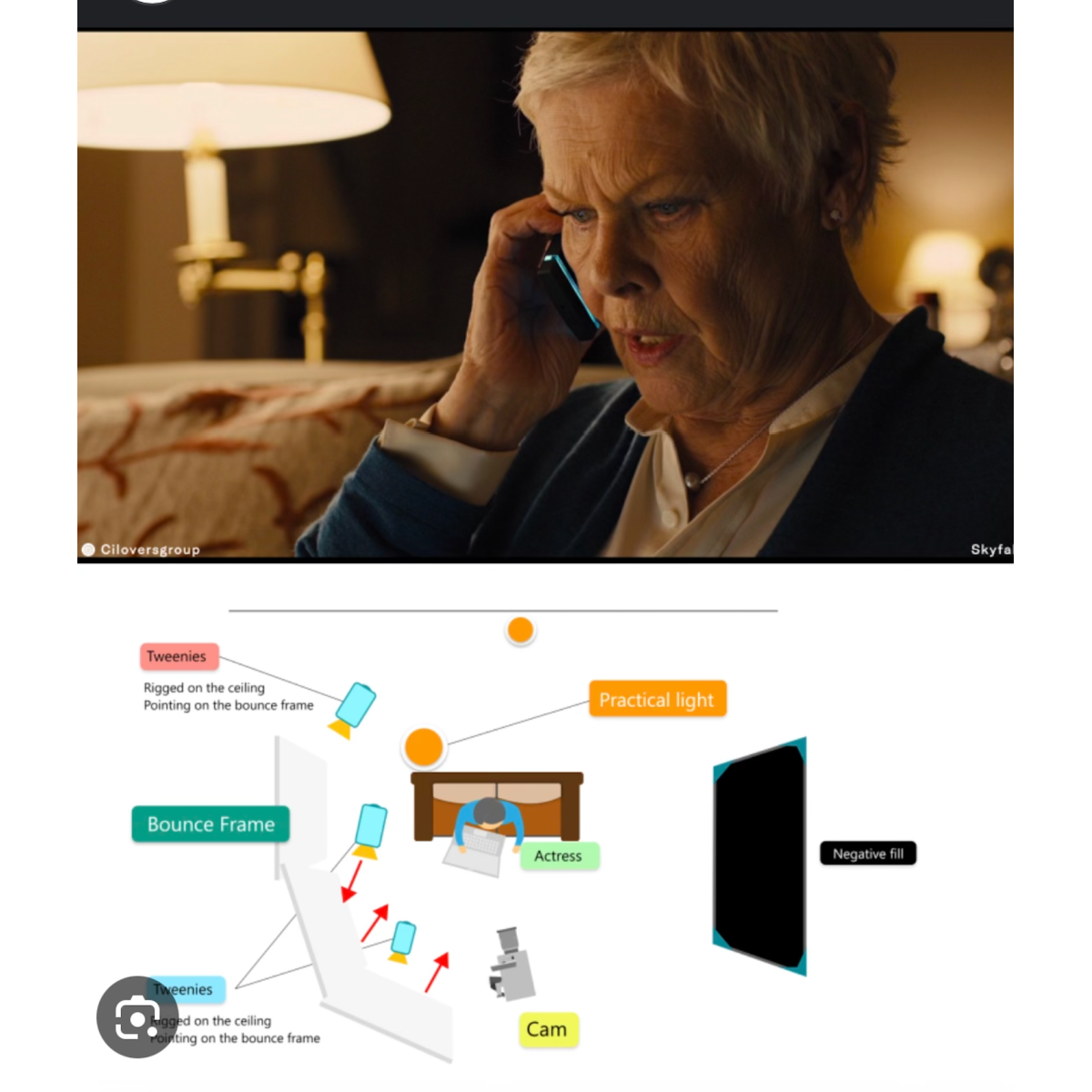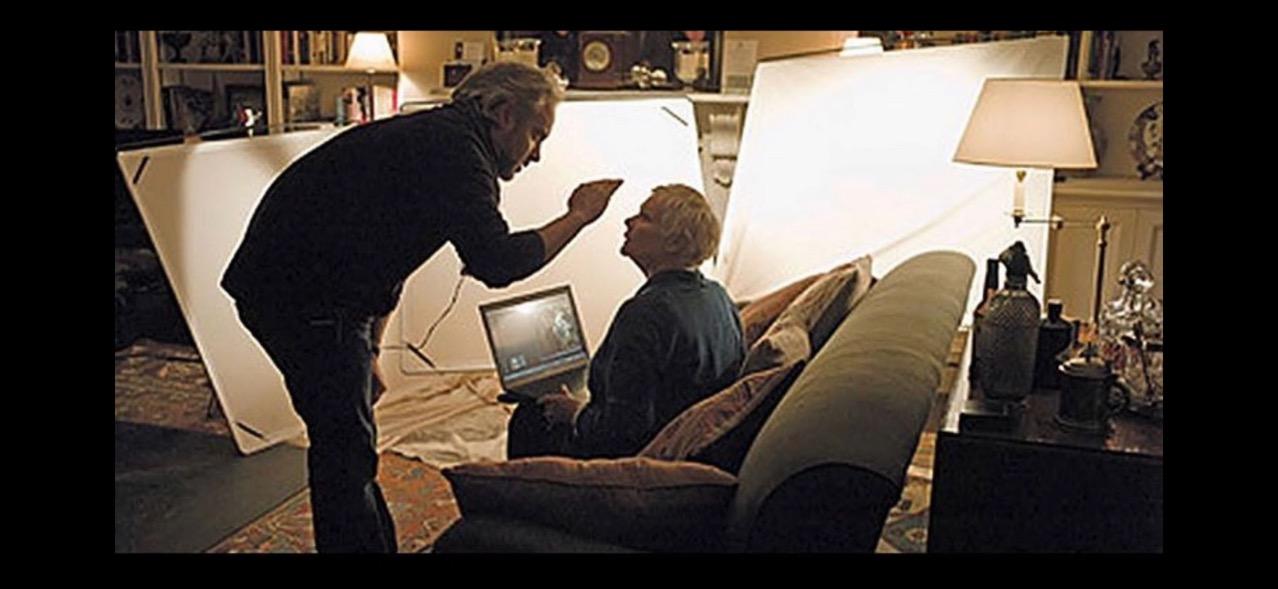Tagged: Cove Lightning, Eye Light
- This topic has 31 replies, 4 voices, and was last updated 11 months, 2 weeks ago by
 Roger Deakins.
Roger Deakins.
-
CreatorTopic
-
June 23, 2023 at 7:03 am #214633
Hi,
I apologize in advance if I try to ask the 1000 question on a topic as a new member 😉
Cove Lightning
Sometimes the lights are on the floor, sometimes the lighting comes from the top: Does this have a big impact on bouncing? Or is it just a space thing?Will the unbleached muslin be doubled? So that no lighting can shine through?
I don’t quite understand yet: will the first lighting be set brighter? And the 2nd less? And the 3rd even more dimmed? Or do all 3 have the same brightness?
If RD uses tungsten lighting in the room and daylight shines through the window, does he use a CTO window film (100, 50, 25%?). Or does he “just” put a gel filter on the camera lens? Or deliberately using mixed light?
Thanks if someone takes the trouble to help a greenhorn …. Thank you so much!!!
-
CreatorTopic
-
AuthorReplies
-
June 23, 2023 at 8:00 pm #214637
The angle of the light to the light to the bounce can alter the size and the shape of the source you create. Whether a lamp is above and rigged to the ceiling or on the floor on a low boy or ‘turtle’ is usually just about space and convenience.
You can double the muslin but it doesn’t make so much difference. The light going through it could be a problem though, and bounce around to interfere with the contrast of the shot.
If I have a series of lamps bouncing off a wide reflector I may, repeat may, dim the lamps to the sides and also warm them up to create a softer fall off and a warmth reaching into the shadow area. I might do that but it is no means necessary.
Whether I gel a light and with what strength of gel in order to maintain color balance is a decision based on the script, the scene and the individual shot. Maybe, you would like the daylight to be blue’ish and the interior lights to be warm. Maybe not.
-
This reply was modified 1 year, 1 month ago by
 Roger Deakins.
Roger Deakins.
June 24, 2023 at 6:50 am #214645Thank you very much for taking the time to have replied to me. Great!
You have given me beautiful moments in cinema with your very personal awesome style of creating films …Can I ask you one more question: When you bounce, do you use an extra eye light? Or only the lighting from the bounce source?
Thank you so much!
June 25, 2023 at 8:55 am #214656I don’t generally use an eye light. That’s something I only use for a specific effect.
June 25, 2023 at 11:53 am #214659Thank you so much for your valuable tips!!
August 1, 2023 at 10:27 am #214754Dear Roger Deakens,
May I ask you a little more about muslin curve lighting:
For example, when I see images from the set, there are often 3 panels around a person (sitting on the sofa, for example): side, curve, front. Obviously the curve doesn’t need to be “half curved” for a better effect (in other images it is sometimes curved)? Or is the effect better curved?
How high will the unbleached muslin be for a “normal” room scene (actors at the dining table, on the sofa, etc.)? Is there an “ideal” height?
And is there an ideal distance from the actor? For example, from the muslin to the sofa where the actor is sitting?
You always say not to be afraid for mixed lighting. How do you handle the color temperatures? In postproduction? Or manual white balance?
Thank you so much for your time and feedback!!
August 1, 2023 at 1:12 pm #214755The distance the bounce source is from the subject controls the ‘softness’ of the light but also the fall off. If you want the wall behind your subject to seem as brightly lit as they are then you have the bounce at some distance away but if you want to isolate a face you then move it close.
The curve I might put into an array of small bounce boards or muslins is to ‘funnel the light when I need to. It doesn’t affect the subject as much as it does the background.
The height of the bounce is a choice made when looking at the natural source you are adding to or emulating. You might also change the height depending on how the light falls on your subject, whether that is an object or a face.
I always control color temperature on set and definitely NOT in post. How to handle color temperature? Maybe that is all about observation of how natural light can change color during the progress of a day or how it varies from one artificial source to another.
August 2, 2023 at 10:10 am #214759Thank you so much for your detailed and helpful replies!
You write:
I always control color temperature on set and definitely NOT in post processing. How do you deal with color temperature? Maybe it’s a matter of observing how the color of natural lighting changes throughout the day, or how it varies from one artificial lighting source to another.But how do you deal with it when the daylight comes from outside and you use table lamps with tungsten lighting inside? Do you work with color gel filters, etc.? Or what do you recommend to prevent an unbeautiful color cast from coming?
(The topic of mixed lighting fills entire tutorials. But there are 1000’s of opinions about it, so I’d really be interested in your expertise).
Thank you so much!
August 2, 2023 at 12:46 pm #214760If I wanted the daylight and practical sources to be the same color temperature I would gel the window with CTO or use a daylight bulb in the lamps. I may have worked like that in the distant past but I more usually allow for some difference in color between light sources, as it more naturally appears to the eye. I just came from doing a remaster of ‘Thunderheart’, a film I shot many years ago now, and I noticed how I often used a bare tungsten bulb in locations that were primarily lit by the daylight coming through the window or doorway. I was bouncing tungsten sources off the ceiling or the wall to augment what the bare bulb was giving me and using the color variation as part of the ‘look’. My ‘moonlight’ was an HMI source, a Musco light, and I combined this with firelight allowing the color difference to be what it was, only using an 81EF on the camera to set the relationship in the middle as far as my tungsten balanced stock was seeing it.
August 2, 2023 at 1:06 pm #214761Some DPs will use 1/2 CTO to correct daylight windows to have less of a difference with tungsten practicals inside.
There were also blue-dipped tungsten photoflood bulbs that were in the mid-4000s in Kelvin — today you could use an RGB LED bulb for some control or a daylight LED bulb if you didn’t want any warmth.
Keep in mind that the blue of uncorrected daylight is often less saturated than when uncorrected HMIs are used for dim moonlight because daylight is brighter in exposure, which washes out some of the blue color. A bright uncorrected daytime window on 3200K film looks less blue than if you put ND1.2 gel on it, for example, and made it a darker window.
August 2, 2023 at 1:23 pm #214763Interesting! Thank you!
I think besides bouncing, the large tungsten ring light is also a really nice light source. It also works really fine as a direct light source (dimmed), as the guys show in the video. I copied it and it makes a nice soft atmosphere 😉
The 2nd image also shows how daylight and tungsten lighting can complement each other. August 2, 2023 at 1:40 pm #214764
August 2, 2023 at 1:40 pm #214764Some DPs will use 1/2 CTO to correct daylight windows to have less of a difference with tungsten practicals inside. There were also blue-dipped tungsten photoflood bulbs that were in the mid-4000s in Kelvin — today you could use an RGB LED bulb for some control or a daylight LED bulb if you didn’t want any warmth. Keep in mind that the blue of uncorrected daylight is often less saturated than when uncorrected HMIs are used for dim moonlight because daylight is brighter in exposure, which washes out some of the blue color. A bright uncorrected daytime window on 3200K film looks less blue than if you put ND1.2 gel on it, for example, and made it a darker window.
Thank you for your comment!
There are also (for example, from Aputure etc.) bulbs where you can completely control the color temperature.
Many also say that RGB LED lamps are easier, what concerns the light tuning on the set. How do you work? RGB? 1/2 CTO?August 2, 2023 at 2:04 pm #214765I still use tungsten bulbs in lamps, partly because the Astera NYX bulb is on the large size and looks odd in a period show inside a lamp. But sometimes I’ve used normal daylight LED bulbs in lamps on location with a lot of daylight windows. I’ve even used daylight LED candelabra bulbs in chandeliers & sconces sometimes. The store-bought LED bulbs can have a bit of green in them though.
Like Roger, I often embrace the color temp differences but on a few locations, I have added 1/2 CTO to windows to reduce some of the difference.Here is a quick test I just did showing that uncorrected daylight feels a bit bluer when it is less bright and washed out:
 August 2, 2023 at 3:00 pm #214766
August 2, 2023 at 3:00 pm #214766Ah, OK. Thank you for the images. Really nice 😉
So for the ‘boy with the guitar’ at the top of the image, no gel was used and the front field was lit with tungsten lighting(?).
The store-bought LED bulbs can have a bit of green in them though.
Which bulbs/brands are “neutral” for you?
And how many watts do you normally use?
August 2, 2023 at 3:15 pm #214767Hello, what would you say is a good rule of thumb is for assembling a cove light setup in regards to the number of lights, the intensity of those lights, and the size of the fabric?
August 2, 2023 at 3:30 pm #214768Roger is the expert and writes about it:


The angle of the light to the light to the bounce can alter the size and the shape of the source you create. Whether a lamp is above and rigged to the ceiling or on the floor on a low boy or ‘turtle’ is usually just about space and convenience.
You can double the muslin but it doesn’t make so much difference. The light going through it could be a problem though, and bounce around to interfere with the contrast of the shot.
If I have a series of lamps bouncing off a wide reflector I may, repeat may, dim the lamps to the sides and also warm them up to create a softer fall off and a warmth reaching into the shadow area. I might do that but it is no means necessary.
The distance the bounce source is from the subject controls the ‘softness’ of the light but also the fall off. If you want the wall behind your subject to seem as brightly lit as they are then you have the bounce at some distance away but if you want to isolate a face you then move it close.
The curve I might put into an array of small bounce boards or muslins is to ‘funnel the light when I need to. It doesn’t affect the subject as much as it does the background.
The height of the bounce is a choice made when looking at the natural source you are adding to or emulating. You might also change the height depending on how the light falls on your subject, whether that is an object or a face.
-
This reply was modified 1 year, 1 month ago by
-
AuthorReplies
- You must be logged in to reply to this topic.
